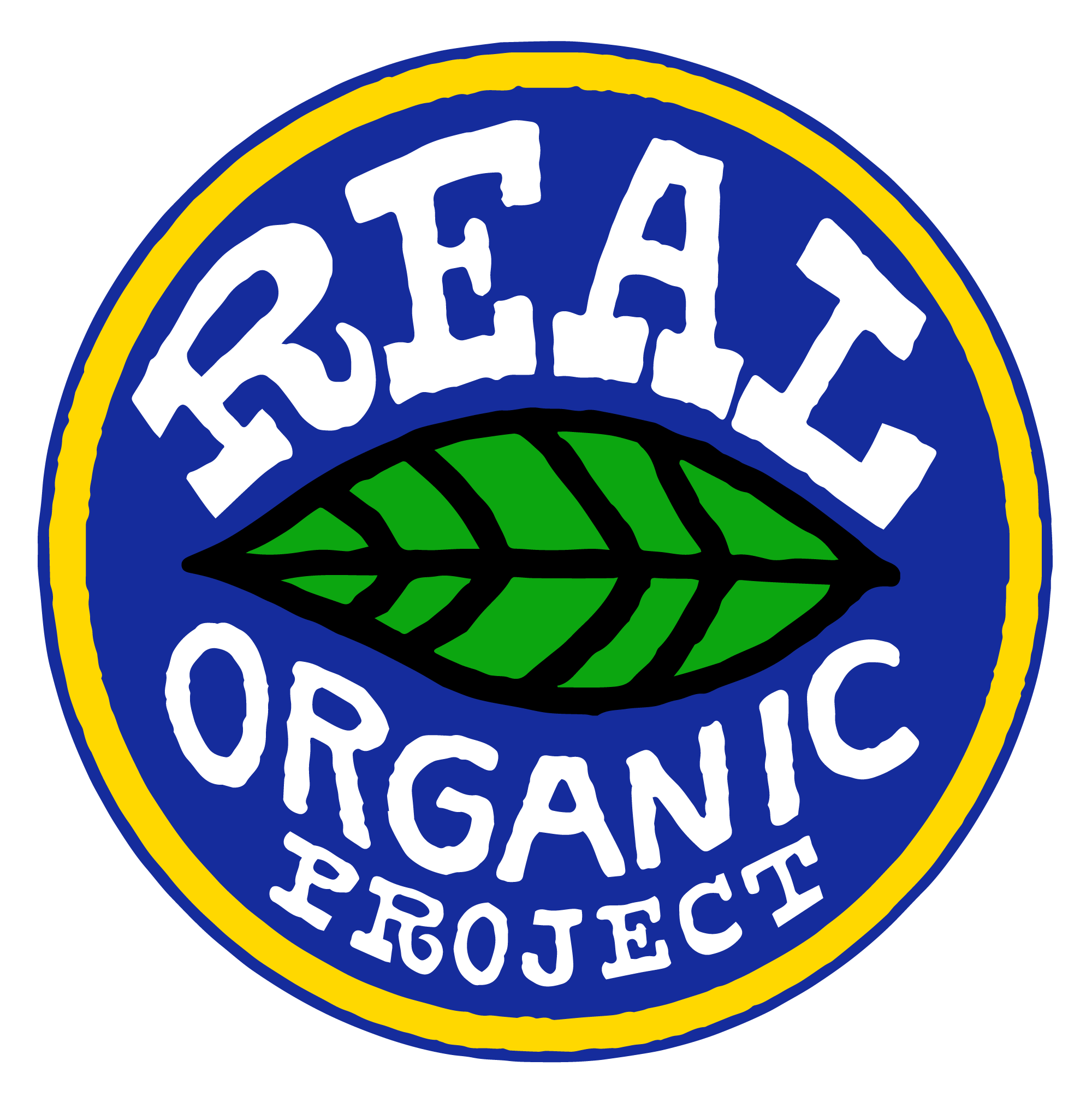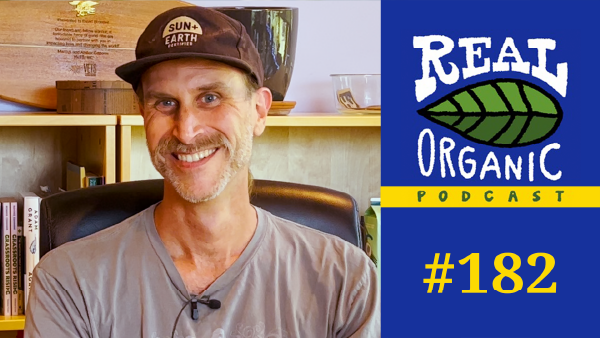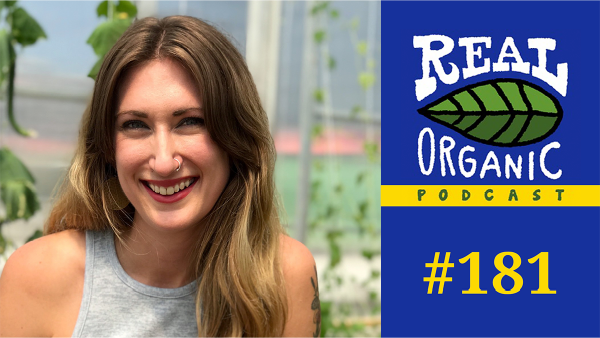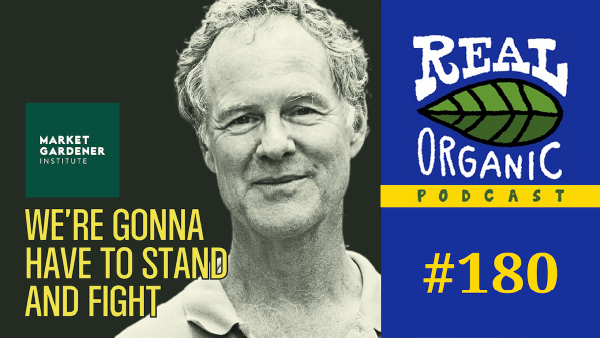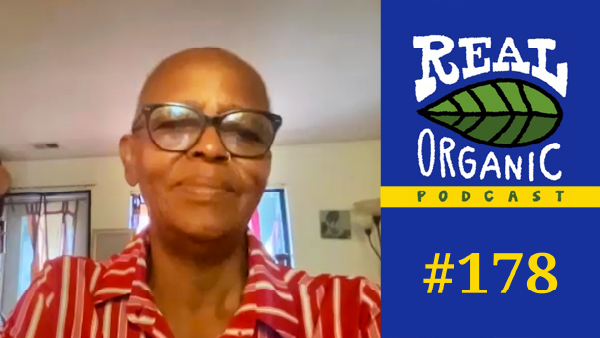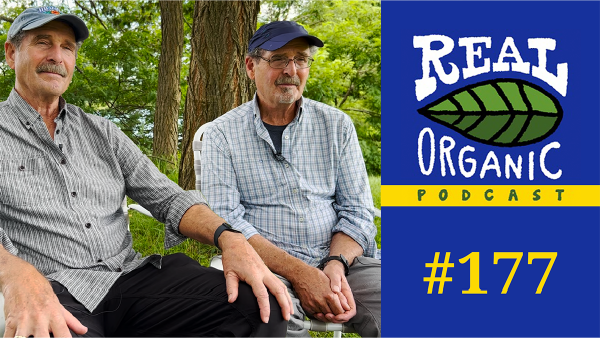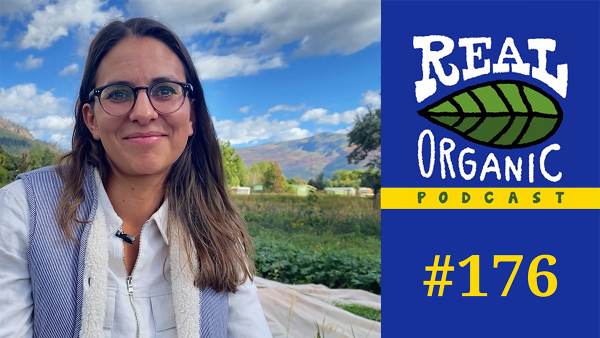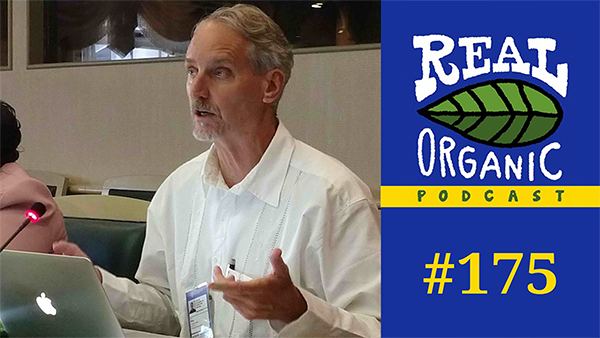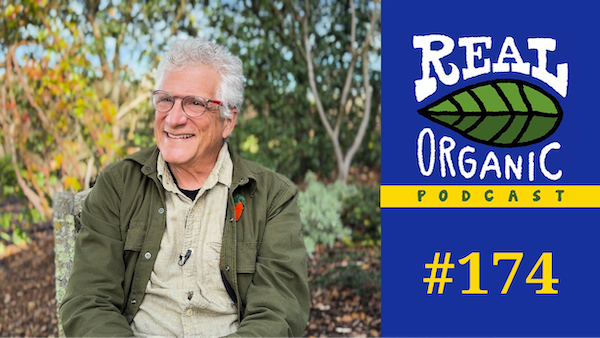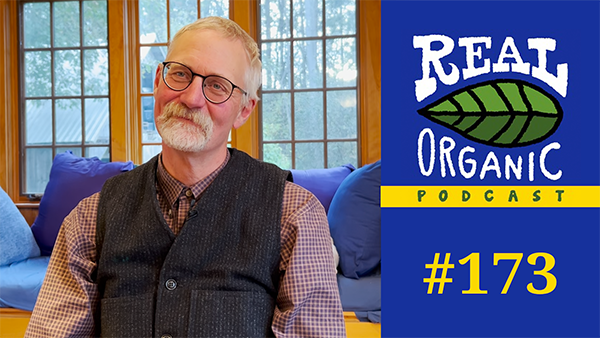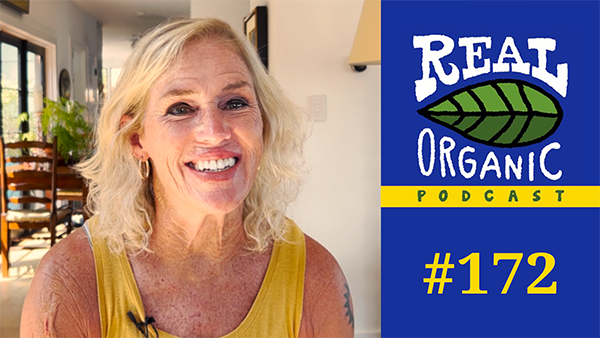Episode #179
Glenn Elzinga Pt 2: Raising Better, More Nutritious Beef
Welcome! You can subscribe and download episodes of our show through your favorite podcast app.
You can also subscribe to receive the video version of each episode on our YouTube channel.
Our Glenn Elzinga interview has been edited and condensed for clarity.
Dave Chapman interviews Glenn Elzinga, October 2023 :
Dave Chapman 0:00
Welcome to The Real Organic Podcast, part two with Glenn Elzinga. Thank you, Glenn, for squeezing us in this morning. You bet. What a great visit. So I’ve heard you talk and in the last four days a lot about the really beauty and brilliance of what you’re doing on older spring ranch. I’d like to talk a little bit about the system surrounding you in the world that that’s embedded in, and not the beautiful natural ecosystem, but the human economic ecosystem. Yeah. And because I people have no idea. And nor do I, and you do so could you describe first what, just a conventional wasn’t mean, conventional beef operation, completely non organic? And, you know, what’s that? Like? What Why do you feel that that’s not? What people should be choosing to eat?
Glenn Elzinga 1:09
It’s a big question, because it’s so dramatically different. So we’re just going to start at the ground level where these calves are born. And that part of it seems, you know, at a glance, pretty innocuous, in terms of differences, you know, it’s mostly tied up and nuanced, but it all becomes kind of cumulative, and its aggregate effects to what the food becomes. So on a conventional Ranch, these calves are usually born in the winter, at least in my area, you know, someplace like Texas, it’s probably winter. But it’s less, the weather conditions are much less adverse. But in our area, a lot of calves are born in January, February and March. And that’s most of them. It’s probably 70% of the calves are born that way. And it’s just, it’s actually a pretty toxic environment for birth. And these producers have been pushed into this place by the feedlots which they sell to in the fall, because in order for them to maximize weight gain, the idea is that you want that calf born as early as you can get it on mom’s side, mom’s lactating and take that calf all the way through to like October or November, at which point it gets on a truck and goes bound for ultimately, the feedlot. So anyway, that I want to talk about that time because that time is actually completely out of the bio rhythm of when these cows are predisposed to calve, by their instinct by the bite, you know, they’re just wired to calve in time of longest length. I mean, that’s how everything else in nature calves. And that’s actually why we shifted gears. Because we were doing it we were doing this January, February thing years and years ago, you know, Carol and I were doing this and it was a struggle, it was just a pure battle. It was a Triumph of the Will, you’re sleep deprived, because you’re up all night, because if you if you’re not out there, and it’s 20 below zero out of you know, she calves out there in a snowbank calves gonna freeze the granted minutes, so you have to get that calf up and suck in right away, make sure she licks it off, if she doesn’t, boy, you’re going to put them in a bar and a lot of people cabinet barn all the time. Because, you know, it’s it’s dry environment. And it’s just, you know, just from an animal husbandry standpoint, you know, I know these people love their cows. And it’s beautiful, the amount of care they put into them. But there’s still quite a bit of stress there. And you got to remember where there’s this disconnect, even at that level. With these people that they’re producing food in most people’s mind that are in conventional cow calf agriculture, they just they just got a huge disconnect with the food, they love what they do, don’t get me wrong, they, a lot of them really honor the cow. And they care for the cow, but to put them in these unfortunate situations where it can be very difficult on cash survival. And when you create all that stress, you’re actually ultimately affecting the quality of your food. And so that’s where it begins. And that’s actually where the mentality hatches out in the mentality I’m talking about is this kind of distanced from nature production model, and it starts that starts in you know, when we did it starts in our minds in January. We have to keep them alive in this absolutely in hot, inhospitable environment. And that means we have to feed the cows, usually terms of plant diversity load diversity rations that have high amounts of protein like pure alfalfa, I often get asked, you know, I’ll go to town or something like that. I was in church the other day. And somebody said to me, how’s that alfalfa crop look this year. And they just assumed that everybody grows alfalfa. And we don’t, we have an alfalfa is one of our plant species, but does monocultures alfalfa that everybody else is striving to grow, so they can get cow survival, good lactation effects. To make it through the winter, is not even a table for us, because we have during the longest days of the year, and, you know, May, June, July, and you know what, we do nothing. We actually have a, you know, there’s like 220 of them. And we actually have a rule that you cannot go out and at 200 acre field, if you’re gonna go out there, you got to sneak around the edge, because we see these very, very important, instinctual behaviors that cows are practicing, like they had these nurseries set up. I mean, it’s a very social organization. It’s very stratified out there. And it’s very intentional on these cows they have that once you kind of reboot that instinct and ml allow them to manifest, they just go crazy and follow that instinct through. So I just want her to present don’t let anybody go out there. Just let the cows do the thing. And it’s so important. And because of that, you know, we have great calving success, we don’t have any illness, we don’t have this thing called scours that ubiquitous in cow calf ecosystem. And you know, it’s uncontrolled diarrhea that absolutely resulted in dehydration and ultimately mortality of like has and it’s, these things are huge kind of toxic calving nightmares, that husbandry nightmares, I get a good friend of mine, a very conventional producer, he’s even calving late. And I was with him at a meeting. And great guy, fantastic guy. But he’s in his paradigm, again, because of the sale paradigm he’s in in the fall. So he’s got to get these calves ready and get it gotta get enough size on. And he’s got about 1500 mama cows that he runs. So that would be potentially 1500 calves. And I know, I knew it was a tough year on and I said, Bill, what are we looking like? How did that go? Like I said, I got most respect for this guy. And he’s way he’s a way better cattleman than I am. He’s just fantastic. And he said, don’t really want to talk about it. And I said, that’s fine. And I turned around to talk to somebody else. And he said, but, but I have to return back to him. I said, What do you got? He said, we lost 400 heads this year. I said, you know, it was like somebody punched me in the guts because I love this guy. And he said, How’d you do? I said I really want to talk about and you knew why he said you’re you’re kind of running close to 100% are alive. I said yeah. So his calving window ends the day the day may one that are starts and this year, you know in high mountain valleys of the intermountain west. That’s exactly when winter quit. And we were getting snow storms like major snowstorms all the way through April even until a little bit into May. But actually you could keep a calf alive starting May one and Mama would cap out there in the field that dirt and green meadows there’s alternative green. And she’d have you know, we we do you know if we’re feeding and supplementing hay out there on our pastures. If we see you know, we were always watching the weather, if we see bad weather coming in, we’ll put them in a place where they don’t get wet exposure so that they can succeed in what they do best. So that’s really where it starts. And it’s it’s unfortunate place that they’ve painted themselves into and it’s because they’re in this feedlot paradigm that starts in October November. So these animals a lot of enter a feedlot at that time. And feedlot pretty simple ration, you know, there’s all that biological diversity that you could be getting that would show up and your food ends up Becoming monocultural. Just almost a reckless adherence to a monoculture in a feedlot bunk and so, you know, either that or guess what they hit a monoculture in terms of green feed and a lot of it is wheat pasture. You know, it’s stuff that’s regrowth from the wheat harvest or maybe they drilled something over it. Maybe it’s like annual rye grass in Oklahoma or Texas on these pivots that are pumping water at the Ogallala. Aquifer aquifer unsustainably, I might add, slowly deepening their wells. You know, it’s so complicated the the,
Glenn Elzinga 10:42
the amount of you know, I can’t really point a finger at somebody say this is wrongheaded. It’s the whole thing that’s wrongheaded. It’s the whole paradigm that we’ve put these beef cattle in, in a production model into and it’s all because we have created a premium for fatty beef in a certain age class, and it’s called USDA is grading system. And it’s, it identifies select cattle choice cattle and prime cattle. And that’s all based on fat deposition, cut in a very specific spot between the 13th and 14th rib on a carcass, and that’s analyzed by a greater and premium is assigned to whether or not those cattle meet those criteria. So that’s the target everybody’s on, you know, at the beginning in January when a calf they are thinking, I gotta get the premium so and if their cow calf guy, they’re just thinking I gotta get the most weight out there by October, November because you get paid by the pound. And that’s the bigger check you’re gonna get then a feed like person takes over, maybe they background and I’m on annual ryegrass pastures and Oklahoma, and Kansas pumping out into the aquifer on those pivots. And then by January, February, March are in a feedlot until the day they die. Average finished period to get to USDA Choice. It’s probably 18 months.
Dave Chapman 12:13
Because are there 18 months in, in the feedlot after?
Glenn Elzinga 12:17
No, it’s 18 months total life lifespan, okay,
Dave Chapman 12:20
yeah, how long in the feedlot so
Glenn Elzinga 12:22
that varies a lot. It depends if they can find like cheap wheat grass pasture rye grass pasture, you know. So that’s called backgrounding. And so you’re just feeding them this monoculture of this grass that you put in and they suck it up. They’re basically in sugar. So that’s it’s the Supersize Me for cattle, okay, because the more we can feed into them, in terms of energy, the faster you’re going to get a gateway. So you know, it’s all about getting energy into those calves. So, you know, foundationally, you’ve built structure as a cow calf producer all the way through summer, turn them out on public lands, grazing. And you’re, you know, sacrificing some of the moms wait towards the end of the summer. She’s feeding her baby. Anyway, this baby is predisposition disposition now, just structurally, physiologically to really gain weight. In those situations calf comes off their range lands pretty dang healthy, because guess what, you know, he or she was grazing this beautiful biodiversity. Albeit, you know, it may be altered by 150 years of continuous grazing, some of that stuff is not so great. But a lot of the public lands ranges out there in the West are still in pretty good shape in terms of, you know, plant diversity, even though community college, they are broken. But anyway, these calves come back and they’re predisposed to really go because they’re in good shape. You know, they’re very healthy. But anyway, then we take them from this huge biological diversity, and we put them onto a monoculture. And guess what they pop, they go crazy. They start laying on pounds like crazy. But this is the problem I have with that as a food item. And I think that that biological diversity, I talked to Fred Provenza once about this, I said How long does it phytochemical richness last year and he said, you know the jury’s out on that he said, but I don’t really believe you’re going to have permanent to those chemicals, those chemicals, those plant compounds beyond save 180 days. So guess what, here we are. Now we go on to these monocultures, these Castile ingesting these very, very simple carbohydrate rich grasses, and then ultimately, carbohydrate rich feedlot rations, you know, which includes stuff like corn dried distillers grains, which happened to be quite toxic, actually, both of them do. And you have to, you know, very closely monitor your animals from acidosis because otherwise they could die. So, you know, there’s a lot of hacks to this. This is why nutritionists if you’re going to run a feedlot you have to have a nutritionist because you want to keep your cattle from dying before they reach that time. You know, so there’s this dance this dance going on, oh, you know, these cattle might die. So I better change the ration accordingly so we keep them alive until they enter
Dave Chapman 15:12
slaughter. So they’re they’re going through the Supersize Me process Supersize Me a great deal like exactly what like the human Supersize Me which it’s like eating junk food, but you’re putting on weight like crazy. Yep. It’s because it’s all energy. It’s all energy. Yeah, yeah. And and it’s got no, none of that diversity of compounds that you find in all these plant species, I think I think they are up to having identified about 100,000. Yeah, these compounds that are there in plants, and then they know there’s unbelievable a million more that we don’t even have a name for. And even of the 100,000 we don’t understand necessarily what role what function that might serve, but we’re pretty sure it serves some function. Yes.
Glenn Elzinga 15:56
Yeah, in for us, not only for the animal, right, we’re talking about us here. And, you know, so then you In contrast, you put them on this corn diet. And what we’re doing now is creating food that has all these inflammatory markers, you know, that are going to cause heart disease that are gonna cause obesity that are gonna cause you know, LDL, LDL and HDL problems in our diet, you know, and it’s just, it’s just like the formula, you know, you could have captured a formula of phytochemicals, or compounds that result from corn and stuff like that and say, Hey, let’s formulate something that’s going to cause illness in humans chronic illness. And we’ve done it really well. You know, and we’ve created a it’s called commercial beef. So from a food standpoint, yeah, absolutely. Not a good idea. And try to stay you know, you know, that eat Lancet thing that came out a few years ago, really pissed off a lot of beef producers and stuff, because these people are saying, hey, you know, for climate change, and for human health, we really need to reduce our red meat intake to under three ounces a week. You know, and, and you know what, you know, what’s weird about that is as a beef producer, I shockingly agree with them. Because if it’s that kind of beef, I don’t even want to eat the three ounces. Okay, no, I’ll pass Thank you very much on three ounces. For me, you know, if you ask me how much how many ounces of red meat I eat a week, I don’t know where it is a week, but a day, it’s around 32 to 40. Okay, 32 to 40 ounces of mine beef a week but somebody else’s beef, there’s, it ain’t no happening deal. I mean, you can force feed it to me, I think I’d rather become a vegan, because this stuff is not good for us. So but then I got to go on the side of the animal as well. And say, from a husbandry standpoint, from just a compassionate care standpoint, of what these animals are, and you know, what they can become in a right system, and what their potential is and what that possibility is in husbandry. I think it’s wrong. I mean, I’ve worked in feedlots, right and fed them the rash, it’s, you know, you sprinkle antibiotics with the ration every day, you put a little bit of Oxy tetracycline in there. And what it turns out to be and people don’t even know why it’s a feed out of that increases, conversion increases. You know, digestion, increases the weight gain. So you put that on here. And it keeps abscesses from becoming infected in your guts. So you’re feeding oxy Tet, maybe once every day, you’re splitting, sprinkling a little under flake, corner, steamed corn ration, whatever you’re doing. We’ve done all this, and they gain weight, like crazy. It’s laughing. We’re feeding 2530 pounds of corn a day to each animal. And it’s, it’s funny watching him gain weight, it’s like holy cow, they are going, you know, and it’s, it’s exciting times because you can convert that animal into very fatty animal. And very short time. So and that’s where that’s the feedlot paradigm. It’s like, you know, that’s perceived as beauty. And it’s it couldn’t be farther from the truth.
Dave Chapman 19:18
So people are getting paid for the wrong thing.
Glenn Elzinga 19:21
They’re getting paid for the wrong thing. Yeah. Instead of nutrient density. We’re just talking about productivity. We’re not talking about profitability in terms of human wellness, we’re talking about productivity in terms of weight gain on a cow.
Dave Chapman 19:39
Vaughn Vaughn and Shiva talks about, you know, she said, we should not be talking about yield per acre, we should be talking about health per
Glenn Elzinga 19:45
acre. Exactly. She’s exactly 100% Right.
Dave Chapman 19:48
Completely different way of looking at everything.
Glenn Elzinga 19:50
You know, there was a I got into an argument with somebody and and it was on a podcast and uh and it convicted me because as like, I need numbers to show this. So they said, Well, you know your models great, Glenn, thank you, thank you so much for contributing, this is a fantastic idea, you know, but the problem is, you know, you got coming 10 billion people on planet Earth and you know, the three ounces of animal protein, Lance it beat Atlanta recommend you, we’re not even gonna be able to grow that according to your model. And I said, you know, I don’t know what that looks like. But let me let me actually put some numbers together. And we never got back together on that subject. But it wasn’t hard. So I just took what my current production is on my, you know, my small place. And the small places, you know, the irrigated pastures, because I said, you know, this is actually more conveyable to like the heartland of America. And so I don’t remember the exact numbers in my head right off the bat, but I was actually very happy. So anyway, right now we’re able to run on irrigated ground about it’s, it’s getting close to 10 Aum per acre, which is 10 Animal Unit months. So basically, I can take 1000 pound animal and keep them alive for 10 months on one acre, by the way, we’re rotationally grazing, and you know, plan grazing and adaptive multi paddock grazing on that place. And it’s just because that’s where productivity is now, you know, we took our soils from 2.45 to 7.75. And so that only took 10 years to get So say we did say we did that on all the lands that are kind of similar rainfall pattern to what we’re doing on all our spring and our homeplace. You know, it’s basically an equivalent about 3035 inches a year. So then I just took, you know, the 100 million head of cattle that are in the United States and apply them to that model. And it’s like, how many acres how many acres. And, you know, what really, really threw me for a loop is I could keep all the soybean ground, I just had to use some of the some of the corn ground and the current pasture ground. And I could grow the 100 million head, I could keep the 100 million head alive in the United States, and it was just done using 10 states worth of ground that’s now being put into, you know, dirt crops, you know, with open soil and uncovered soil. And it’s like, this is not impossible, this is actually 100% doable. And we can provide food that’s actually real food now, you know, that’s nutrient diverse food, you know, and get that density that people can live on and thrive on and, and not eat three ounces, way more than three ounces, they can eat like Glen eats, you know, in terms of that kind of red meat consumption. Because now I’ve said this red meat is delivering this incredible phytochemical richness from all these plants that you start picking up as you invest in your soils, because as you invest in your soils, you start just naturally picking up we didn’t plant our home pastures, we started out with really three species. Now we’re up to 80, that seed bank was there that are traveled in from adjacent wild ground. And it’s there it’s it’s ready for us to just drop the chemicals and start withdrawing from that kind of system and create a new system that’s like resilient and nutrient dense and
Dave Chapman 23:43
and the inputs on that land in terms of like something you brought from somewhere else. Are there any? You
Glenn Elzinga 23:51
know, I had a friend of mine call me he was trying to become an organic producer. And he said, I don’t know what you’re doing about fertilizer, but it’s killing me. I said, What’s that mean? And he said, It’s killing me. I spent $160,000 last year on organic fish, animals and fertilizers. He said it’s killing me. What are you using? And I said, you’re kidding me. Right, Joe? He said, No, it’s killing me. I can’t do this. He said, What do you use? I said, Well, I think you’ve heard it’s called Hey, he said what? I said it’s called Hey. He said, What do you mean? You said you’re growing hate? I said, No, no, we’re feeding hay. I said so we feed this hay just like you do on our fields. And we’re just very organized about how we lay that hay across the fields or cattle eat it right out there. We don’t ever put them in a corral. They’re always outside. So we’re supplementing our stockpile grazing with this hay. And I said so we’re importing biomass. And I said there’s willing producers of hay everywhere. I want to sell you this biomass. So and I couldn’t even find organic A, it’s everywhere to put on the ground and feed these cows. And he said, So what are you talking about? I said, Well, you’re talking about importing biomass. And when you pour biomass, you’re feeding yourself. Well, I said, he gotta get out of your mindset that you’re feeding your cows. For us, the actual soil comes first in terms of feeding, I said, so when you put the hay on the ground, you’re creating biological activity, because they’re always going to waste them. You know, in fact, when we feed hay, even if it’s high dollar, expensive hay, which it was last year, we’re still wasting about 10% of it, we’re planning on wasting 10% of it, because for one, we got a grass fed beef finishing program, I don’t want him to eat the junky hey, I want him to walk on it and lay on it and just put that cellulose and lignin down against the ground, okay, and put it in contact with the soil. And for second it is feeding the soil. So I’m just planning on that much loss. And for third, it’s actually providing some thermal insulation from animals that are going to lay on that stockpile and hay. And especially young calves are going to keep warm, or they’re going to have better thermal efficiency. And for fourth, it’s going to create more thermal efficiency for the soil itself. Because the soil is still biologically active. i And Nicole Master spent a bunch of time with me, we talked about winter soil. And she said it’s still actually measurable. The life that’s going on, in soils at sub zero temperatures above ground, when you have biologically active soils, they’re still alive and kicking. They’re kicking slowly, but they’re still kicking, even when it’s 20 or 30 degrees below zero. So
Dave Chapman 26:44
the hay is being fed. When it’s cold. Yeah, that’s, that’s when you bring in the hay and
Glenn Elzinga 26:51
yeah, so it’s a huge biological input. It’s biomass. Wow. You know, it’s, it’s like you with compost?
Dave Chapman 26:56
is a hard question. Yes. What about the land where the hay comes from?
Glenn Elzinga 27:01
So that’s, you know, what? I was talking to a certifying person, you know, and I said, you know, I think it was even in the context of real organic. And, and I said, so what about them? What about them? I’m, you know, I’m extracting these cattle from their place, because we’re buying some certified organic yearlings. And the thing we did about the certified organic yearling purchase from other people is we made sure we went there, my daughter, and I would go there, and ask Melanie as we’re driving out to drive, okay, what do you give them a scorecard? What do you give them? Because they had to be kind of, you know, the same vibe of husbandry, you know, as we were, you know, I’ve been to places you know, we’re gonna buy cattle, they got rock, you know, country rock music going loud, or running hot shots. You know, they’re just super loud with the cattle that are, you know, chasing them with four wheelers. And it’s like, 100%. You know, I think what we’re doing when we buy cattle from people like that, and we never do, is we’re actually buying their, you know, adrenals that are that are in those cattle, because they’ve been stressed out all their life, you know? And, you know, that might turn into histamines or whatever. I don’t know, but I just think all those inflammatory stress markers are not something we ever want in our food. Right. So anyway, I asked this person about I said, so what about those cattle and they said, you know, that’s not your problem. That’s their problem. If they want to export hair, cattle, and organic or real organic, they do have to figure out that budgeting system, you know, so it’s not mining, it’s not extractive use. So he said, you know, just focus on your own deal, because he’s gonna, you can do this forever, right? You can just say, Wait a second, we took this from here, you know, like, we use Redman mineral, you know, and it comes out of the ground. So I think that’s cool, you know, but what if we got it from somebody else, you know, say, you know, what, Dave, what about the chicken manure, you know, that you might input into your compost, right.
Dave Chapman 29:06
But my question is, just, I’m just curious. I know a guy, lifelong organic farmer. And he said, Well, of course, organic doesn’t work without haber bosch. And I’m like, What? What are you talking about? And he said, Well, he’s from California. He said, All these organic farms are working off compost from CAFOs. And those CAFOs are all fed with haber bosch, nitrogen. Yes. And I’m like, Okay, that’s a valid conversation. Let’s have it. And so I’m curious, can you grow hay sustainably, without ultimately relying on an input like that? In other words, can that be also a self fed farm?
Glenn Elzinga 29:48
I think you can be okay. Yeah, that is that’s got to be your business. That’s gotta be your I get it. That’s gotta be your business. Hopefully you got some animal impact on your place to mitigate the extract Active loss from removing that biomass. Yeah. So, you know, and that’s something we all have to do. It’s our duty to do that. Otherwise, you’re gonna end up with soil depletion. Right? Right, you’re gonna be hurting your own biology. So, you know, I don’t know what that looks like, you know, if it were me, I would say, Hey, we’re only going to take, you know, it’s kind of like milk. For me, it’s analogous to milk, okay, I’m going to haul this milk off. And we’re extracting that, you know, it’s slightly analogous to beef, you know, but I think that’s further removed. But you know, that milk is consistent energy flow that’s outside of your system. And your consumers are never giving back. They’re never giving back some sort of byproduct that they don’t show up with a bag of compost from your own process. And say, Here, Tim, here’s your, you know, here’s your exchange for that milk, you’ve been giving me that energy flow. So that means that Tim with the dairy has to really conceptualize how he’s going to mitigate that energy flow. But the thing what we have here, in soil is this incredible, regenerative system. You know, it’s creating something out of nothing. It’s taking mineral material in our soil or parent material, and creating life from that, you know, and we need to be there in that place to facilitate that relationship, to build soils, because we can build them, you know, I think you and I were just talking about, I think it was you. Were talking about how this, you know, just 10,000 years ago, at the end of the last glaciation, this was parent material, man, we’re standing on parent material here, there’s no organic matter, you know, and yet, here we are, here we are, we get the northern hardwood forests, we get all these beautiful manners. There’s a lot of organic matter matter here. There’s a lot of soil that has developed since that time. And that’s a short time geologically. But the cool thing is that that regenerative power Underground is so much that we could do it, you know, easily within our lifetime. We can do it over and over within our lifetime and facilitate that
Glenn Elzinga 32:06
we can become the facilitators. Yeah, we can we can we can be a catalyst. You know, it’s
Glenn Elzinga 32:11
really a catalyst instead of saying, Oh, just, you know, let’s let natural process continue. But we can come in here and say, we’re going to catalyze the natural process, and really move it forward. And so
Dave Chapman 32:24
let me ask you, so you, you, you were just talking about the process of regeneration. And, of course, there is now a movement that means many things to many people. And I’m just curious. So you talked about conventional, AG, kind of what that looked like, and the feedlot and then you’ve talked to me about regenerative and what does that mean, in your world? Well,
Glenn Elzinga 32:52
yeah, so there’s 100 million uses of that word, and many, many, many, many of them today are inappropriate. Remember, just you know, 2030 years ago, it’s all sustainable ag, well, is this sustainable? Now that word is everywhere, right? So it’s become an unfortunate you know, just the unfortunate divisor demise of a buzzword that’s got no certification behind it, that’s got no third party, check in. That’s the value of organic, that’s the value of real organic. But for me, regenerative is still, you know, personally, it’s a valuable word, because that means that we’re actually we’re moving forward in terms of building life or adding life to assist him. You know, even if there’s all processes of agriculture are somewhat extractive. I mean, Tim is removing milk from the system, we’re removing beef from our system, we’re taking it off that ground. But you know, I was driving down our road that runs right through the middle of ranches called out in lane, and as looking at that. And I thought it a 1000s and 1000s, and, you know, maybe millions of pounds of beef, that have left that ranch. And it was just incredible to me that we could do that, you know, this perceived extractive removal of this million pounds of beef that has come off that ranch. And, you know, the cool thing for me, you know, on one side of it was, well, we’ve provided real food for people, you know, we’ve given them real nutrition. But the other side of it, in spite of that, we’ve been able to build life and add life, you know, in terms of both, you know, the sub soil ecosystem, which I become extremely focused on in the past few years. And the above ground ecosystem, you know, the biodiversity of not only those plants, you know, those 85 species of plants on a potent homeplace that 2200 plants up on that wild range land, but also that you You know, the ungulates, the amphibians, and all that stuff. And that’s, that’s what excites me about the word regenerative, because that really is what we all have the potential to become agriculture. But we have to look to nature, you know, that grand design and say, How did this function before we start dinking around with it? And what lessons can we learn from that? To be the catalyst to create that regenerative presence? You know, a lot of people think are the cap to soil biology, soil organic matter? It’s like, well, it’s going to end here. And I’m skeptical, because right now, you know, we’re only surveying that top 15 cm, you know, the top 15 centimeters, that’s all we’re doing our survey on, because guess what it’s, you know, Rocky, crap glacial deposit underneath it. But I know, I know, because we have deep rooted perennials, if somebody has alfalfa, so reach, or clovers that we have, we have tons of different kinds of clovers now. And a lot of the grasses are reaching down as far as 10 feet underground. And I know they’re putting the deep organic matter down, they’re putting deep carbon in there, very difficult to volatilize, that it’s locking it down there forever. And it’s because we’ve changed from just this kind of ephemeral, annually based system into a long term, perennial system. So I guess that’s what’s so exciting to me about regenerative, that’s right, because I’m creating something for the far distant future. You know, I’m bringing something back from a failed system, where, you know, people who are ignorant, and it’s not ignorant in a bad way, it’s just the fact of the matter was genuine, genuine ignorance, and I was there, I was there just 30 years ago, because I took soil science, right. and Soil Sciences was structured in chemistry, those two things, we hardly talked about biology, we hardly talked about it. And now, you know, we’re just opening a door on this thing. And we’re just getting to skin the surface of what that actually means, you know, what does it mean? That when you have a teaspoon of soil, and it’s got more living inhabitants in it, then people on Earth, you know, there’s 10 billion critters in a teaspoon of good soil? What does that even mean? And who are those inhabitants, we have no idea, we have no idea. And we, we are just beginning to start to see relationships and that kind of activity. But yet, this is what’s exciting, we don’t have to know. We can just say, have added guys. And we started to figure out how to create those relationships, to allow them to just take off. And that’s what’s so exciting, because I’m still ignorant. I’m still ignorant, but yet it’s happening, you know, and so that means the bar is low for us to be successful here. We don’t have to be like huge solo bio biotic agents, you know, we don’t have to understand all this stuff. You held up a bunch of worms and your tomato crop yesterday, and you said, this one I don’t think is good. And this one, you know, and, you know, but we don’t have to even know that we don’t even have to know those particulars, because it’s an ecosystem, and they’re gonna fight it out on our own. All we got to do is be there to facilitate their action.
Dave Chapman 38:27
And it’s just like you said in the field, like, the greater the diversity of species, the better it all works out. It does. So we’re trying to facilitate the diversity Jack and it will work it
Glenn Elzinga 38:39
out. Yeah. And we can walk through there and see it, you know,
Dave Chapman 38:41
so So I gotta ask you a hard question. So okay, that you’re talking about regenerative as a concept and as a way of understanding the world. What about regenerative certification? Because that’s coming right now.
Glenn Elzinga 38:54
Gosh, you gotta hit me with this. Yeah, yeah, I
Dave Chapman 38:56
just, you know, did
Glenn Elzinga 39:00
you know, I guess, great idea, but um, you know, I’d have to see it to believe it and see how it’s gonna work. Because right now people are claiming regenerative and there’s different people who are quote, unquote, certifying that I don’t see any consistent there’s absolutely 100% No, Kitces and Jesse, you know, soybean growers who are raising biological deserts just because they’re out there No, till, you know, they’re, yeah, we’re regenerative. All of a sudden soybeans, you know, go from biological desert to regenerate. And I’m not getting, I’m not getting to me. I smell a rat in or somewhere, you know, and the rats not on the ground. By the way, he can’t live in a soybean field because there’s, there’s nothing alive in soybean field except soybean plant, you know, it’s, it’s a toxic environment. And I’m scratching my head. I’m saying, Dave, I’m saying I’m not buying it. I’m not buying it. And until I see some Integrity of what it looks like in terms of actually sustaining and enhancing nature. I can’t get on the bandwagon. I’m very unexcited. Now about the regulatory expression of where this word may go. It’s very disappointing.
Dave Chapman 40:21
Let me ask you another hard question. Because we talked about it some, you also felt that the regulatory world around organic I’m not talking about real organic, but USDA organic, is slipping even more in and what does that mean? What like what what kind of things are being permitted that you go that that should not be called Organic? Yeah.
Glenn Elzinga 40:44
And I think it’s slipping in more ways than we can even be cognizant of. Because there’s an infinite amount of pressure, you know, maybe, I don’t know if I technically call them lobbyists. But it just feels like there’s like there’s multitudinous ways that people are attempting to Nagel at the letter of the law. They’re certainly trying to neglect the spirit of the law, we know that we know there’s people who are just 100% in organic for economic gain. So anything we can do, you know, to try to mitigate that. I’d like to see happen, but I don’t even know what that looks like, because I can’t even guess where it’s gonna come from next, you know, so I don’t even know where these things come from, like, you know, for instance, my organic inspectors looking in my vet shed the other day, and they’re like, oh, Fenichel, you know, that’s, you know, its trade name, new floor. I think no, it’s prevail. These are anti inflammatories. They’re basically nascence for cattle and non steroid, non steroidal anti inflammatory drugs. You know, it’s like ibuprofen for cattle. And she said to me, you know, that’s legal. That’s actually legal and organic. I said, Wait, what wait is 100% synthetic? Substance? 100%? I mean, organics, no synthetics, right? And she said, Yeah, but this one’s legal. Now you can use it, you don’t have to tell anybody, we do ask that you record it record to use, but there’s no disclosure required on your customer Association. And it was like, somebody just kicked me into get there, you know, it’s like, Wait, you’re telling me to be not upfront with my customers. Now. I don’t have to tell them that I use a synthetic compound in the raising of their animals, you know. And that, to me, you know, there was a huge issue, because all sudden, I just felt like, violated, because I’m part of an organization now and, you know, associated with the NOP that now has, like, intentionally created a system, where we’re doing things under the table that the consumer doesn’t need to know about, we’re doing this, but yet we’re organic. And to me, that’s hugely unfortunate. It’s, it’s, it’s really a little devastating to me, when I see that stuff happening, you know, it’s, it happened with, you know, the ability of you to do anything with a cow. And that’s in the first two trimesters, you could, you know, you could put poor odds on that animal, you could, you know, Doctor them for antibiotics or whatever, you know, first two trimesters of life, where that calf is in utero, and I’m like, well, we hold on a second, who said that, you know, that cast not affected in utero. During those first two trimesters, I mean, these are formative trimesters, right? We know that, you know, human gestation, hugely formative, where everything’s getting hooked up, all synapses are joining and all this stuff, you know, all this hugely, you know, critical the systems are putting getting put in place and yet we can apply chemicals to the calf at that point. And still considered organic, you know, and yeah, so that’s, that’s a very frustrating situation me to be in because I feel like everywhere I look, every time I turn around, there’s another there’s another surprise for you know, that would be a potentially extremely negative surprise for the consumer to find out about what’s happening to the brand of organic. And you know, these things don’t get publicized. It’s like the NOP says, Oh, by the way, were allowed, you know? So it was like this thing where? Oh, no, you can use that, you know, it’s my inspector, he’s telling me this. So the consumer has no idea. You know, and I think most people just roll with it. I said, Cool, man. Yeah, nice. It’s for cattle. I’m gonna do it all time now. Fantastic. You know, and I don’t need to tell my consumer. And that’s weird. Okay, that’s a weird place to be. You know, where we’ve built this consumer trust. You know, I write people I write a blog and I get people respond to it a lot of times. And you know, people are like, the reason I won’t buy from you if you’re not certified organic is because it’s too much to ask for me to trust you. I haven’t been here place. I’m in Florida. I’m never gonna get there. I need that third party certification. So, you know, it’s that’s the critical need for them. Yeah. Who are they going to trust when they find out that USDA is nickeled and dimed to death? They can trust no one. Yeah.
Dave Chapman 46:06
Well, that’s what we’re trying to do. That’s what we’re trying to do. So I want to bring it home, because you gotta go. There’s so much more to talk about,
Glenn Elzinga 46:16
oh, gosh, we can just hang out,
Glenn Elzinga 46:17
I know, we have that. It’s been fantastic. A lot of times, you know, this,
Glenn Elzinga 46:22
we end on a serious note. But it’s, it’s still a lot of fun. And we’re laughing a lot. Because it’s, it’s a great place to be. It’s there’s so much potential here, especially when we start seeing it. You have something like soil has more life than we ever imagined. You know, it’s just kicking our butt to find out what is possible. And that thing we used to call dirt. You know, it’s just so exciting to see that foundation expand, and sit down and go out and your tomatoes are in my on my place and my grand and pick up a load of that stuff. You know, for us, it’s almost bentonite is all these fine clays. Originally, when we got there, it was white soil. And now it’s dark, and it’s got aggregate and it smells. It smells heavenly. It’s just as beautiful smell that resonates in us. And so you start seeing stuff like that. And it gets really exciting. Yeah, it gets you up in the morning.
Dave Chapman 47:20
Yes, it is exciting. Glenn Elzinga. Thank you so much. Well, thank you, thank you for what you do. Thank you for what you do. I’m serious. It’s it’s, you really. You inspire a lot of people. And I think that what happens is that grows and that grows and then they inspire people do people start to do it differently. And one of the things that you and so many other of these organic pioneers prove is that this does work.
Glenn Elzinga 47:48
Yes. Yep. It works. It does. Yeah. And it’s easy to find out for yourself. That’s right. It’s easy to facilitate that change. It’s so easy, because nature is powerful. It’s way more powerful than we are odd times. All we need to do is get out of the way. All right.
Dave Chapman 48:05
Thank you, Glenn.
Glenn Elzinga 48:06
Thank you, Dave. It’s been great.
